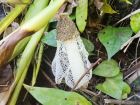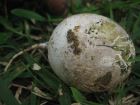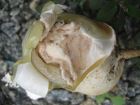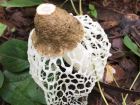Cap narrowly bell-shaped with a small hole at the apex leading into the hollow stem. The surface is reticulated with distinct pits and ridges, initially covered by a foul-smelling, greenish-brown slime (gleba) that partly obscures the texture. As the fruiting body matures, a lacy white net (indusium) is exuded from beneath the cap, hanging down like a delicate skirt around the stem. Stem is cylindrical and hollow, tapering slightly upward, emerging from a tough, membranous volva that is smooth and wrinkled on the outside, and white to pinkish or lilac-tinged on the inner surface. Spores yellow. The spores suspension in gleba makes it impossible to produce a conventional spore print.
Immature fruiting body appears as a whitish, brownish, or pinkish "egg," which when sliced reveals the stinkhorn-to-be encased in a gelatinous substance.
Microscopic Features: Spores measure 3.5–4 by 1.5–2 µm. They are elongated-ellipsoid in shape, smooth, and appear hyaline in KOH.
Phallus indusiatus on the First Nature web site.
Phallus indusiatus MushroomExpert.Com web site.
The second photo is by TecheOldFox, and the third and fourth photos are by OikosES and licensed under the Attribution-ShareAlike 3.0 Unported license.
Many mushrooms are poisonous, and some can be lethally toxic. Distinguishing between edible and poisonous mushrooms can be very challenging. Therefore, we strongly advise against consuming wild mushrooms. This website does not contain any information about the edibility or toxicity of mushrooms.
Although efforts have been made to ensure accuracy on this website, the information may contain errors and omissions. Therefore, all content provided is for educational and informational purposes only and should not be relied upon or used as a basis for consuming any plants or mushrooms.
External links are provided for reference only. We do not endorse or take responsibility for the content, advice, or products found on these sites or in any advertisements shown on this website.




